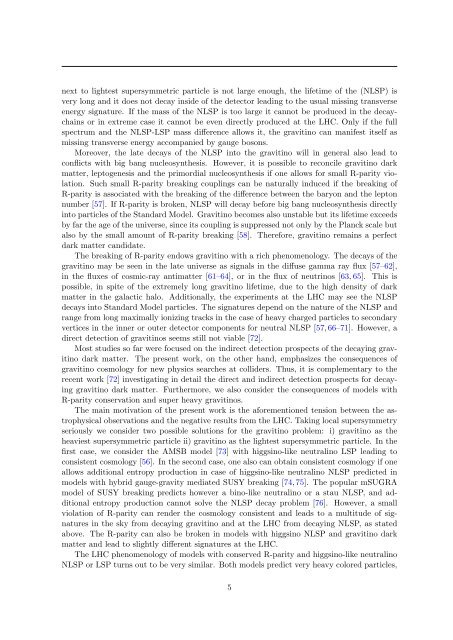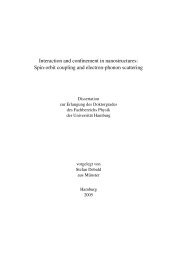Gravitinos and hidden Supersymmetry at the LHC - Universität ...
Gravitinos and hidden Supersymmetry at the LHC - Universität ...
Gravitinos and hidden Supersymmetry at the LHC - Universität ...
You also want an ePaper? Increase the reach of your titles
YUMPU automatically turns print PDFs into web optimized ePapers that Google loves.
next to lightest supersymmetric particle is not large enough, <strong>the</strong> lifetime of <strong>the</strong> (NLSP) is<br />
very long <strong>and</strong> it does not decay inside of <strong>the</strong> detector leading to <strong>the</strong> usual missing transverse<br />
energy sign<strong>at</strong>ure. If <strong>the</strong> mass of <strong>the</strong> NLSP is too large it cannot be produced in <strong>the</strong> decaychains<br />
or in extreme case it cannot be even directly produced <strong>at</strong> <strong>the</strong> <strong>LHC</strong>. Only if <strong>the</strong> full<br />
spectrum <strong>and</strong> <strong>the</strong> NLSP-LSP mass difference allows it, <strong>the</strong> gravitino can manifest itself as<br />
missing transverse energy accompanied by gauge bosons.<br />
Moreover, <strong>the</strong> l<strong>at</strong>e decays of <strong>the</strong> NLSP into <strong>the</strong> gravitino will in general also lead to<br />
conflicts with big bang nucleosyn<strong>the</strong>sis. However, it is possible to reconcile gravitino dark<br />
m<strong>at</strong>ter, leptogenesis <strong>and</strong> <strong>the</strong> primordial nucleosyn<strong>the</strong>sis if one allows for small R-parity viol<strong>at</strong>ion.<br />
Such small R-parity breaking couplings can be n<strong>at</strong>urally induced if <strong>the</strong> breaking of<br />
R-parity is associ<strong>at</strong>ed with <strong>the</strong> breaking of <strong>the</strong> difference between <strong>the</strong> baryon <strong>and</strong> <strong>the</strong> lepton<br />
number [57]. If R-parity is broken, NLSP will decay before big bang nucleosyn<strong>the</strong>sis directly<br />
into particles of <strong>the</strong> St<strong>and</strong>ard Model. Gravitino becomes also unstable but its lifetime exceeds<br />
by far <strong>the</strong> age of <strong>the</strong> universe, since its coupling is suppressed not only by <strong>the</strong> Planck scale but<br />
also by <strong>the</strong> small amount of R-parity breaking [58]. Therefore, gravitino remains a perfect<br />
dark m<strong>at</strong>ter c<strong>and</strong>id<strong>at</strong>e.<br />
The breaking of R-parity endows gravitino with a rich phenomenology. The decays of <strong>the</strong><br />
gravitino may be seen in <strong>the</strong> l<strong>at</strong>e universe as signals in <strong>the</strong> diffuse gamma ray flux [57–62],<br />
in <strong>the</strong> fluxes of cosmic-ray antim<strong>at</strong>ter [61–64], or in <strong>the</strong> flux of neutrinos [63, 65]. This is<br />
possible, in spite of <strong>the</strong> extremely long gravitino lifetime, due to <strong>the</strong> high density of dark<br />
m<strong>at</strong>ter in <strong>the</strong> galactic halo. Additionally, <strong>the</strong> experiments <strong>at</strong> <strong>the</strong> <strong>LHC</strong> may see <strong>the</strong> NLSP<br />
decays into St<strong>and</strong>ard Model particles. The sign<strong>at</strong>ures depend on <strong>the</strong> n<strong>at</strong>ure of <strong>the</strong> NLSP <strong>and</strong><br />
range from long maximally ionizing tracks in <strong>the</strong> case of heavy charged particles to secondary<br />
vertices in <strong>the</strong> inner or outer detector components for neutral NLSP [57, 66–71]. However, a<br />
direct detection of gravitinos seems still not viable [72].<br />
Most studies so far were focused on <strong>the</strong> indirect detection prospects of <strong>the</strong> decaying gravitino<br />
dark m<strong>at</strong>ter. The present work, on <strong>the</strong> o<strong>the</strong>r h<strong>and</strong>, emphasizes <strong>the</strong> consequences of<br />
gravitino cosmology for new physics searches <strong>at</strong> colliders. Thus, it is complementary to <strong>the</strong><br />
recent work [72] investig<strong>at</strong>ing in detail <strong>the</strong> direct <strong>and</strong> indirect detection prospects for decaying<br />
gravitino dark m<strong>at</strong>ter. Fur<strong>the</strong>rmore, we also consider <strong>the</strong> consequences of models with<br />
R-parity conserv<strong>at</strong>ion <strong>and</strong> super heavy gravitinos.<br />
The main motiv<strong>at</strong>ion of <strong>the</strong> present work is <strong>the</strong> aforementioned tension between <strong>the</strong> astrophysical<br />
observ<strong>at</strong>ions <strong>and</strong> <strong>the</strong> neg<strong>at</strong>ive results from <strong>the</strong> <strong>LHC</strong>. Taking local supersymmetry<br />
seriously we consider two possible solutions for <strong>the</strong> gravitino problem: i) gravitino as <strong>the</strong><br />
heaviest supersymmetric particle ii) gravitino as <strong>the</strong> lightest supersymmetric particle. In <strong>the</strong><br />
first case, we consider <strong>the</strong> AMSB model [73] with higgsino-like neutralino LSP leading to<br />
consistent cosmology [56]. In <strong>the</strong> second case, one also can obtain consistent cosmology if one<br />
allows additional entropy production in case of higgsino-like neutralino NLSP predicted in<br />
models with hybrid gauge-gravity medi<strong>at</strong>ed SUSY breaking [74, 75]. The popular mSUGRA<br />
model of SUSY breaking predicts however a bino-like neutralino or a stau NLSP, <strong>and</strong> additional<br />
entropy production cannot solve <strong>the</strong> NLSP decay problem [76]. However, a small<br />
viol<strong>at</strong>ion of R-parity can render <strong>the</strong> cosmology consistent <strong>and</strong> leads to a multitude of sign<strong>at</strong>ures<br />
in <strong>the</strong> sky from decaying gravitino <strong>and</strong> <strong>at</strong> <strong>the</strong> <strong>LHC</strong> from decaying NLSP, as st<strong>at</strong>ed<br />
above. The R-parity can also be broken in models with higgsino NLSP <strong>and</strong> gravitino dark<br />
m<strong>at</strong>ter <strong>and</strong> lead to slightly different sign<strong>at</strong>ures <strong>at</strong> <strong>the</strong> <strong>LHC</strong>.<br />
The <strong>LHC</strong> phenomenology of models with conserved R-parity <strong>and</strong> higgsino-like neutralino<br />
NLSP or LSP turns out to be very similar. Both models predict very heavy colored particles,<br />
5

















